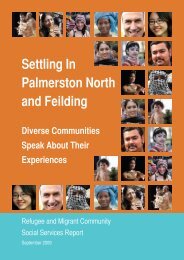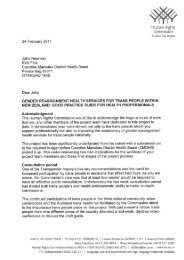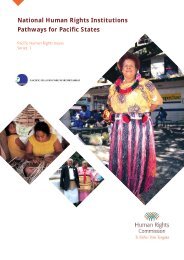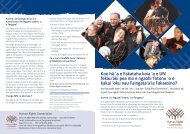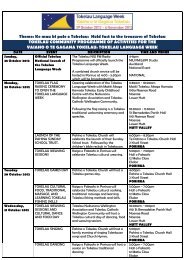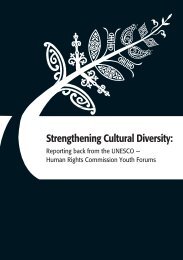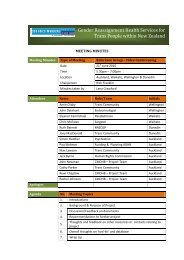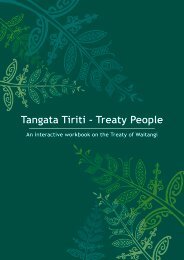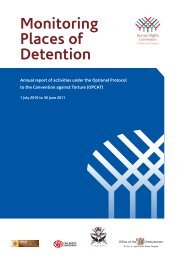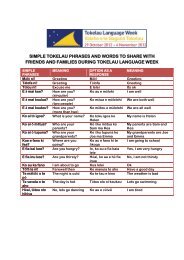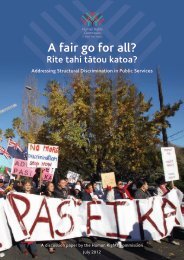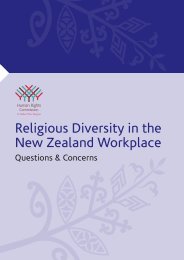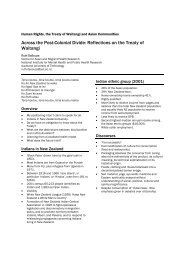10 HUMAN RIGHTS COMMISSION | STATEMENT OF INTENTOur operating intentionsTä mä<strong>to</strong>u koronga whakahaere<strong>Human</strong> rights are our core business. They are reflectedin our goals that people in New Zealand enjoy theirhuman rights, duty-bearers uphold their human rightsresponsibilities, and people live <strong>to</strong>gether harmoniously byshowing a common respect for each other’s human dignity.We direct our activities <strong>to</strong> the critical human rightsissues facing people in New Zealand, as well as buildinga greater understanding and respect for human rights inour communities. Every year we review the human rightssituation in New Zealand <strong>to</strong> determine where we cantake practical steps and make a positive contribution <strong>to</strong>achieving improved human rights outcomes for everyone inNew Zealand. From our review <strong>of</strong> the current human rightssituation in New Zealand, we have designed our workprogramme around four outcome areas:1 work and education2 housing, health and community3 violence and abuse4 human rights mainstreaming.In this section, we analyse what the current situation is inrelation <strong>to</strong> each <strong>of</strong> these outcome areas, set out what wewill do <strong>to</strong> achieve improvements in these areas, identifywho we will work with in carrying out our activities, andwhat impact we intend <strong>to</strong> make in these outcome areasthrough the services we provide.In detailing what our operating intentions are over the nextthree years, we acknowledge our support for the outcomes<strong>of</strong> other agencies where these complement our ownpriorities. In particular, in aspiring <strong>to</strong> improve educationalachievement <strong>of</strong> children and young people fromeconomically disadvantaged areas and with disabilities, and<strong>to</strong> reduce violence and abuse within secondary schools, ourwork programme complements the Office <strong>of</strong> the Children’s<strong>Commission</strong>er’s priority focus which is <strong>to</strong> improveoutcomes for children.The following diagram sets out our foundations, outcomeareas, the key services we provide, and our key externalaudiences.<strong>Human</strong> <strong>Rights</strong> <strong>Commission</strong><strong>Human</strong> rights foundations• Treaty <strong>of</strong> Waitangi 1840• New Zealand Bill <strong>of</strong> <strong>Rights</strong> Act 1990• United Nations Paris Principles 1993• <strong>Human</strong> <strong>Rights</strong> Act 1993• International human rightsinstrumentsOutcome areas• Work and education• Housing, health and community• Violence and abuse• <strong>Human</strong> rights mainstreamingServicesEducation, promotion and advocacy• human rights education, advocacy andawareness programmes• community development programmes• good practice guides• <strong>to</strong>ols and resourcesEnquiries and complaints, and legalinterventions• information, referral and disputesresolution process• legal interventionsOffice <strong>of</strong> <strong>Human</strong> <strong>Rights</strong> Proceedings• legal representationMoni<strong>to</strong>ring and reporting• advice and guidance <strong>to</strong> government andcivil society• engagement with civil society <strong>to</strong> identifyissues• provision <strong>of</strong> analysis and information<strong>to</strong> duty-bearers and international treatybodiesExternal audiences• Influencers and decision-makers• Public• Interest groups and partners• Media
HUMAN RIGHTS COMMISSION | STATEMENT OF INTENT11Outcome area one:Work and educationOutcomeStructural discrimination and barriers <strong>to</strong> equality eliminatedso all people in New Zealand have access <strong>to</strong> decent andproductive work and quality education.Situation analysisInequalities in employmentWomen continue <strong>to</strong> be paid approximately 10 per centless than men on a median hourly basis and are overrepresentedamong workers earning at, or just above, theminimum wage. Women remain under-represented inleadership roles in both the private and public sec<strong>to</strong>rs. Thegender pay gap in the public service is wider than that <strong>of</strong>the whole labour force. These inequalities are more acutefor Mäori women, Pacific women, young women, andwomen with disabilities.Despite the ethnic composition <strong>of</strong> the public servicebroadly matching the ethnic composition <strong>of</strong> the NewZealand population, significant ethnic inequalities in payand management roles persist across the public sec<strong>to</strong>r.Mäori, Pacific and Asian peoples are under-represented insenior leadership roles. The pay gap between Mäori andEuropean New Zealanders is 11 per cent, while it is 19 percent for Pacific peoples, and 12 per cent for Asian peoples.Population-wide, Mäori and Pacific rates <strong>of</strong> unemploymentare three times higher than that <strong>of</strong> European NewZealanders, while the rates <strong>of</strong> unemployment <strong>of</strong> peoplefrom other backgrounds (Asian, Middle Eastern, LatinAmerican and African) are approximately twice as high.Employment data on people with disabilities is collectedinfrequently. In all three disability surveys <strong>to</strong> date,conducted as part <strong>of</strong> the general Census, people withdisabilities <strong>of</strong> working age are more than twice as likely asnon-disabled people <strong>to</strong> be unemployed. We will contribute<strong>to</strong> the work <strong>of</strong> the Disability Convention independentmoni<strong>to</strong>ring mechanism on guidelines on reasonableaccommodation in employment, led by the Office <strong>of</strong> theOmbudsman.Young people have been disproportionately affected bythe global financial crisis and, when they are able <strong>to</strong> findwork, are <strong>of</strong>ten employed in more vulnerable sec<strong>to</strong>rswhere there is less job security, high turnover, lower wagesAll human beings are born free and equalin dignity and rights. They are endowedwith reason and conscience and shouldact <strong>to</strong>wards one another in a spirit <strong>of</strong>brotherhood.Article 1, Universal Declaration <strong>of</strong> <strong>Human</strong> <strong>Rights</strong>International human rights standardsThe International Covenant on Economic, Social andCultural <strong>Rights</strong> (ICESCR) refers explicitly <strong>to</strong> equalopportunities at work and establishes the maininternational human rights standards relevant <strong>to</strong>this outcome, along with core International LabourOrganisation conventions. Both ICESCR and the Conventionon the <strong>Rights</strong> <strong>of</strong> the Child provide for the right <strong>to</strong>education. Other human rights standards further assertthese rights for identified vulnerable population groups.and more part-time and casual hours. The unemploymentsituation <strong>of</strong> Mäori and Pacific youth is acute. The Pacificyouth unemployment rate is at least twice that <strong>of</strong> the youthunemployment rate for European New Zealanders; the Mäoriyouth unemployment rate one and a half times. Disabilityadvocates and commenta<strong>to</strong>rs note the double disadvantagein the labour market <strong>of</strong> being both disabled and young.Provincial and rural New Zealand communities areparticularly vulnerable <strong>to</strong> lay<strong>of</strong>fs in dominant locationbasedindustries. The loss <strong>of</strong> several hundred jobs from onecompany or one industry in smaller centres has a much moresignificant effect on the whole community than is the casein urban New Zealand.Inequalities in educationMäori and Pacific peoples continue <strong>to</strong> experience significantdisadvantage in terms <strong>of</strong> educational outcomes. Incompulsory education, approximately 50 per cent <strong>of</strong> Mäoristudents leave school with no educational qualificationscompared <strong>to</strong> 21 per cent <strong>of</strong> the overall population. Pacificexpulsion rates are over three and a half times higher thanfor New Zealand European students; the expulsion rate forMäori students three times higher.



